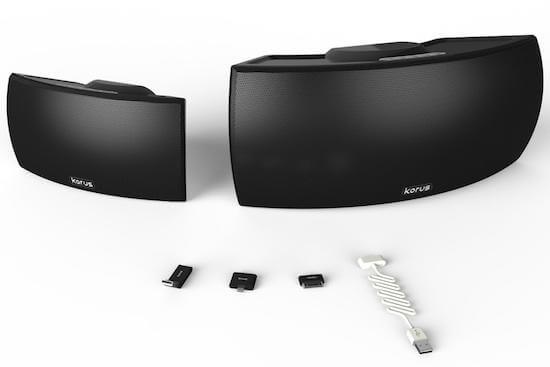
The engineers at Korus recognized that wireless interference and distance issues can be a major flaw in both wi-fi and Bluetooth speaker systems and set out to engineer their own solution.
They come up with two new speakers, the V400 and the the V600, that both use the proprietary SKAA networking standard. SKAA creates a direct connection between the streaming device and the speaker, aiming to eliminate the dropouts that plague wireless music systems.

I've spent a lot of time using both the V400 and the V600 and these are the only wireless speakers that deliver a consistent connection in a house full of wireless devices and thick plaster walls. Once the connection is made, the Korus speakers just work.
Korus is a consumer audio company started as a division of Core Brands, LLC which is in turned owned by Nortek. That's not just something I copied from the press release: Core's companies have a long history in utility, security and home theater smart-building and connected-home controls. They're bringing that network experience to a consumer product and that history shines through in the design and the performance. (They've also partnered with the Gary Sinise Foundation to put some of their technology in the homes Gary's building for wounded veterans).
The V400 is a 11" x 6" by 5.5" speaker that weight 4 1/2 lbs and retails by itself for $299 (but you're going to need a bundle, more on that below). The V600 goes for $399 and bumps up the size to 17" x 9" x 7" and weighs in at 11 lbs.
If dropouts make you crazy but you still want the benefits of controlling your music from a smartphone or tablet, then Korus is the solution you're looking for. Of course, like every other wireless streaming technology, there are a few trade-offs that you'll need to consider.

Design
Both the V400 and the V600 look like they're components in those early-'90s monster truck audio systems that were trying to knock off the designs from the PA systems everyone recognized from arena rock shows. That's not a knock on the Korus speakers. In a world full of marginally successful attempts at "sleek" design, these things are defiantly chunky and utilitarian. You're not going to drop the speaker because the handle is too small and you can wrap the power cord around the handle and still have no trouble holding on to your investment.
Sound
Keeping with the arena rock theme, these things are really loud, much louder than speakers of comparable size. They're keyed to deliver on the classic rock/'80s rock/contemporary country end of the musical spectrum. Mid-range guitars cut through. You shouldn't rule them out for contemporary pop or hip hop but they're not bass-heavy in the way that's become the fashion for consumer audio over the last couple of years. I wouldn't use the Korus speakers for critical listening on any of my pro audio work, but that's not the task these things were built to perform.
Controls
So what's the catch? Is it a catch? To create the SKAA network, the Korus speakers require you to plug in a tiny dongle to your iPhone, iPad or computer. You then pair the device with the speaker and should be good from that point on. The reviews out there talk about how dead-simple the setup is, but I didn't have that experience at first.
I tried to set up an iPhone, iPad and laptop with both the V400 and V600 all at once after a cursory glance at the setup instructions. Some of that's my own impatience, some of it's a conscious attempt to act like a regular customer who doesn't read the directions. I fouled the whole thing up, but once I cleared all the devices and then set up each connection one at a time, everything worked as advertised.

The pairing is controlled by the button with the two facing arrows on the speaker and you use that same button to switch between devices. The switch controls which device the Korus is looking for and the button cycles through the devices in the order you added them. That can be confusing if you're not paying close attention as you add the devices. Both the Lightning and USB transmitters are nearly impossible to mess up once they're up and running. The 30-pin connector requires an app that you download from the iTunes store.

The V600 also takes 6 "D" batteries and promises up to 90 hours of playback, which will be a surprise to anyone who remembers the "1-hour-per-battery" reality back when they had to use "D" batteries to power a boom box.
I really like both of these speakers a lot and they're sure to seem like a miracle to anyone who's been irritated by whatever Bluetooth or AirPlay speakers they've tried in the past, but Korus speakers are most definitely not for a person who can't keep track of small items like USB jump drives. These connectors are even smaller than a jump drive. I'd like them better if each came with a small ring you could use to attach them to a keychain or clip in your bag. Seriously, you should probably budget for at least one replacement transmitter over the life of the speaker.
The fewer individuals who are sharing these devices, the easier it's going to be to keep track of the settings on the speaker. You can share a connector between devices. Rather than buying three lightning connectors, it's probably better to connect one and pass it back and forth.

The USB, Lightning and 30-pin connectors sell for $49.99 each. Since the connectors take over your charging port, Korus also makes a $19.99 USB power cable that plugs into the Lightning and 30-pin connectors and allows you to charge your device and stream music at the same time. You can also address the "lost dongle" issue by leaving the connector attached to the cable when it's not plugged in to your iPhone or iPad.
You're going to have to invest in at least one of those connectors when you buy a speaker, so your best bet is to buy the bundles. For $349.99 for the V400 or $449.99 for the V600 (only $50 more for each), you get one of each connector and two of the USB power cables.
That price puts the Korus squarely in line with the entry-level prices of higher-end brands like Bose, Sonos and Cambridge Audio. The difference here is the SKAA network. Korus demoed a future TV solution at CES this past January and it promises to deliver audio to their speakers with no lag. Anyone who's had the sound get out of whack with the image when using AirPlay knows how irritating that can be.
The Korus V400 & V600 have been the most consistently reliable speakers I've tried out this year. Once you're connected, the signal doesn't break up. Classic rock and mainstream country sound great. The connectors are a little complicated for all the reasons listed above, but that's the price of admission for the more consistent streaming quality.
If you're looking for a multi-room setup, adding a V400 to the V600 is a cost-effective solution. If I were picking one, the V600 gives a lot more bang for the extra hundred bucks. If you've got the space and don't mind the weight, that's definitely the best choice.
I've been surprised how spotty the connections I've gotten from wi-fi speakers have been at my house, even though I shouldn't because I've always had dropout issues with the Apple Airport Express when it's been connected to a stereo system. The Korus absolutely solved that issue in my house.
If the connector/connection situation sounds too complicated for you, Korus is worth watching as the company develops future products. They'll improve the transmitters (how about building them into a line of iPhone cases?) and the controls on the speakers themselves will continue to evolve.




